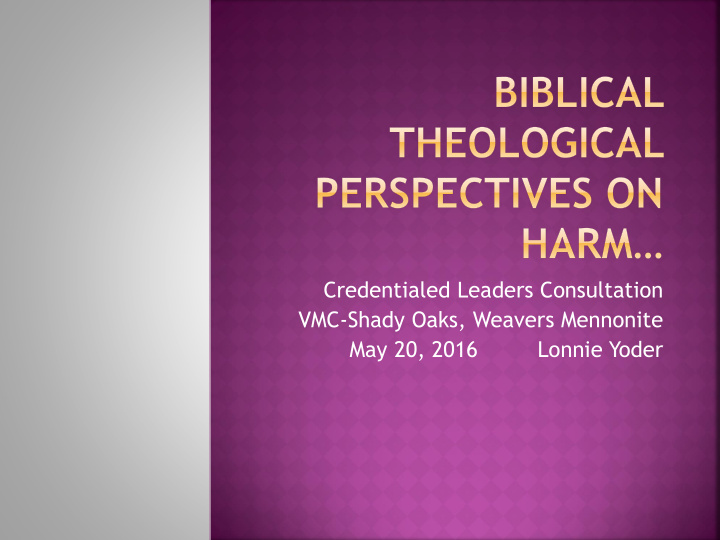



Credentialed Leaders Consultation VMC-Shady Oaks, Weavers Mennonite May 20, 2016 Lonnie Yoder
“a” set of biblical theological perspectives (not “the” or “the best” set…) Our biblical theological understandings inform our practice in significant ways Exegeting the title of this consultation “restorative approaches” = goal (telos) “broken boundaries” – highly contextual “community of faith” – important lens
Theological anthropology = “what we believe about human beings from a Christian perspective” Continuum exercise in Pastoral Care course A “three - fold cord” of understanding (creation, fall, redemption) Ecclesiastes 4:12 – “And though one might prevail against another, two will withstand one. A threefold cord is not quickly broken.”
Every human being is created in the image of God – Gen. 1: 26-27; Psalm 8: 3-5
That image (imago dei) has been shattered/broken resulting in sin and human finitude – Gen. 3-4; Romans 3:23
God through Jesus Christ provides a context for redemption, restoration, reconciliation – Col. 1: 15-20 esp. vv. 19-20 (wholeness, unity, salvation)
Grade B movie approach – good people who are pure; bad people who are evil through and through
“If only it were all so simple! If only there were evil people somewhere insidiously committing evil deeds, and it were necessary only to separate them from the rest of us and destroy them. But the line dividing good and evil cuts through the heart of every human being. And who is willing to destroy a piece of his own heart?” ― Aleksandr Solzhenitsyn, The Gulag Archipelago 1918- 1956
A necessary dynamic to factor into both our individual and community reflections One expression of the complexity
Situations of harm, broken boundaries, etc. Every pastoral situation My own life and functioning
Everyone is affected by a violation based both on where they find themselves with respect to the violation and their own life experiences and roles.
1) key parties 2) family and friends 3) concerned parties 4) bystanders or witnesses 5) those who hear 2 nd /3 rd /4 th hand
Telos all over the text V. 12 – “to equip the saints” V. 12 – “building up the body of Christ” V. 13 – “the unity of faith” V. 13 – “the knowledge of the Son of God” V. 13 – “maturity” V. 13 – “the measure of the full stature of Christ” Vv. 15-16 – grand summary – “but speaking the truth in love…”
Process -v. 13 – the word “until” - v. 15 – “we must grow up in every way …”
A picture of the body -v. 16 – “the whole body joined and knit together by every ligament with which it is equipped, as each part is working properly, promotes the body’s growth in building itself up in love.”
In our congregational and community contexts, many, esp. including pastors, carry multiple and intersecting roles Pastor AND family member, friend, mentor, ally, confidante, etc.
What is your functional theology when it comes to working with harm and broken boundaries? How might your functional theology need to be changed/tweaked to be more faithful and helpful? How much is your functional theology in your awareness as you practice as a leader/pastor? How might you bring your functional theology into even greater awareness?
Recommend
More recommend